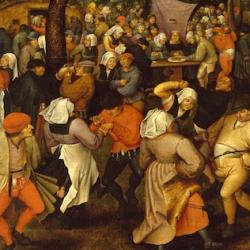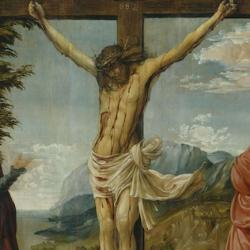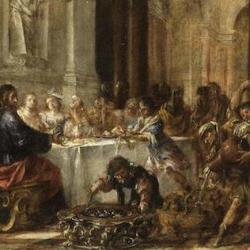Some additional notes on John 5, largely indebted to Gary Burge’s NIV Application commentary.
It has been said that the synoptic gospels ?EMatthew, Mark, and Luke ?Eare essentially passion narratives with long introductions. That is not really a fair way to describe what goes on in the synoptics, and this certainly does not apply to the John?s gospel. Of course, John?s gospel ends with the story of Jesus?Etrial, sufferings, and death, but in John?s gospel particularly, the trial begins much earlier than chapter 18. The trial of Jesus really begins here in John 5.
This is the beginning of a section of John?s gospel that focuses on Jesus?Efulfillment of various OT festivals. Chapter 6 is about the Passover, chapters 7-8 take place at the feast of tabernacles, chapters 9-10 are about Hanukkah, the festival of lights that celebrated the recovery and restoration of the temple in the time of the Maccabean revolt. Here in Chapter 5, the issue is the Sabbath day, and Jesus?Ehealings on the Sabbath day, which is the weekly festival of the Jews, the first festival in the list of festival days in Leviticus 23.
As so often in John?s gospel, Jesus performs a miracle, and the story of the miracle is told briefly. But the focus of attention in the chapter is not on the miracle itself but on the conflict that ensues after the miracle. That is the case in this chapter. Jesus heals a paralytic, or what we would call a paraplegic, who cannot make his way to the miraculous waters in the pool of Bethesda. Here is a man who has been suffering paralysis for thirty-eight years, the same period of time that Israel was in the wilderness. He has not been able to pass through the waters into the promised land; he has not been able to gain rest. Now, on the Sabbath day, Jesus comes and with a word takes the paralytic out of the wilderness and into the promised land. The Word of Jesus gives life.
Immediately the trial begins, but the first one to be put on trial is not Jesus but the paraplegic. Jesus heals the man and then, as He often does, immediately disappears, slips through the crowd, and leaves the man to face the Jews himself. This foreshadows the end of the gospel, when Jesus rises from the dead ?EHis greatest miracle ?Eand then slips away into heaven, leaving us, the church, to face those who had persecuted and hated Jesus. As soon as the man begins carrying out Jesus?Einstructions by carrying his cot, he is confronted by the Jews, zealous to enforce Sabbath regulations. The man does not even know Jesus?Ename, but tells the Jews that the man who healed Jesus told him to carry his cot. When the man realizes that it is Jesus who healed him, he tells the Jews, and they immediately turn their prosecutorial zeal onto Jesus Himself.
Notice the sequence here. The man is put on trial, and appeals to Jesus. And then Jesus returns to the story, and takes the man?s place in the dock. This is the whole story of the gospel in a nutshell: Jesus, the Word who was with God, the Word who was God, takes flesh, to stand in the dock for us. Jesus suffers prosecution and persecution on our behalf.
The remainder of the chapter is an intricate trial scene, filled with the language of the courtroom ?Ewith talk of judges, judgment, witnesses, and testimony.
The Jews charge Jesus on two counts. The first is that Jesus has violated the Sabbath by healing the paraplegic. This reflects Jesus?Ecommon practice on the Sabbath: ?The Jews were persecuting Jesus, because He was doing these things on the Sabbath?E(v. 16) ?Enot merely ?this one thing?Ebut ?these things.?EJesus doesn?t conform Himself to the law of the land ?EHe is a maverick, a lawbreaker.
Jesus?Edefense of His Sabbath practice does not satisfy the Jews. It merely provokes a second charge, that Jesus has made Himself equal with God. Jesus has defended healing on the Sabbath by saying ?My Father is working until now, and I Myself am working?E(v. 17). For the Jews, the first Sabbath day, since it never had an end, continued to the present. God had entered into rest at the end of the week of creation, and continues in rest. But the Jews also recognized that Yahweh necessarily worked on the Sabbath; the world, after all, did not dissolve every Sabbath day, which meant that God continued to sustain it, and people were born and died on the Sabbath, which meant that the Lord of life and death must be active. When Jesus defends His life-giving healing on the Sabbath, He is saying that He keeps Sabbath in the same way that God does. The Jews conclude that Jesus considers Himself ?equal with God?E(v. 18).
The charges have been made, and in verse 19 the trial begins. Again, Jesus refuses to hedge or back down, and His defense offends as deeply as the original offense of Sabbath-breaking. Two key things happen in His defense.
Jesus defends Himself by calling witnesses. He operates by the law, which requires that everything be established by ?two or three witnesses,?Eand calls on five: the Father (v. 32), John the Baptist (vv. 33-35), His own works (v. 36), Scripture (vv. 39-40), and finally Moses Himself (vv. 46-47). By the end of the ?trial,?Ehowever, Jesus completely turns the tables on His opponents and places them on trial. Religious though they are, insistent as they are on conforming to their ideas of Torah, they are spiritually dead. They ?do not have His word abiding?Ein them (v. 38). The Scripture are witnesses for Jesus, yet the Jews search the Scriptures and refuse to ?com to Me, that you might have life?E(v. 40). They ?do not have the love of God?Ein them (v. 42). They form a community of mutual admiration, receiving glory from one another rather than glory from the Father (v. 44). Jesus could turn prosecutor and accuse them before the Father, but they are already condemned by Moses (v. 45). The sequence is striking: The healed paraplegic is put on trial; Jesus takes His place as His substitute; and then Jesus ends up prosecuting the prosecutors.
Behind all these maneuvers, and the point I wish to focus on, is the fact that Jesus does all this in imitation of the Father. Jesus describes His relationship to the Father as a kind of apprenticeship: Just as a father teaches his son a trade, and the son learns by imitating the father?s life, so Jesus has learned to do all He does by watching what the Father does.
He does ?nothing of Himself?Ebut only what ?He sees the Father doing?E(v. 19). In particular, the Father gives the Son authority to pass judgment and the power to give life to those who hear and believe His word. Jesus?Eactions in this chapter, in short, are grounded in the work of the Father.















